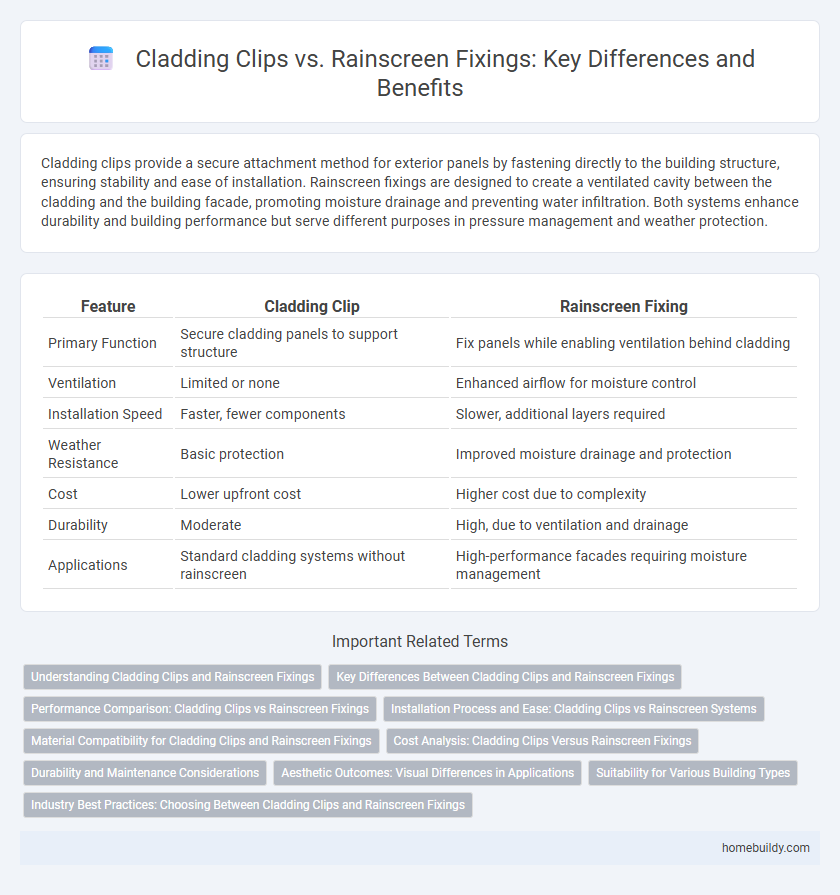Cladding clips provide a secure attachment method for exterior panels by fastening directly to the building structure, ensuring stability and ease of installation. Rainscreen fixings are designed to create a ventilated cavity between the cladding and the building facade, promoting moisture drainage and preventing water infiltration. Both systems enhance durability and building performance but serve different purposes in pressure management and weather protection.
Table of Comparison
| Feature | Cladding Clip | Rainscreen Fixing |
|---|---|---|
| Primary Function | Secure cladding panels to support structure | Fix panels while enabling ventilation behind cladding |
| Ventilation | Limited or none | Enhanced airflow for moisture control |
| Installation Speed | Faster, fewer components | Slower, additional layers required |
| Weather Resistance | Basic protection | Improved moisture drainage and protection |
| Cost | Lower upfront cost | Higher cost due to complexity |
| Durability | Moderate | High, due to ventilation and drainage |
| Applications | Standard cladding systems without rainscreen | High-performance facades requiring moisture management |
Understanding Cladding Clips and Rainscreen Fixings
Cladding clips provide secure attachment points for panels, enabling efficient installation and allowing for thermal expansion and contraction, which enhances the building envelope's durability. Rainscreen fixings, designed specifically for ventilated facade systems, create an air gap that improves moisture drainage and prevents water ingress, ensuring long-term facade performance. Understanding the difference between cladding clips and rainscreen fixings is essential for selecting the appropriate system that balances structural support with weather resistance.
Key Differences Between Cladding Clips and Rainscreen Fixings
Cladding clips secure exterior panels to a building's framework, providing a hidden, durable attachment method that maintains a flush surface and ensures even load distribution. Rainscreen fixings, conversely, are designed to create a ventilated cavity between the cladding and the wall, promoting moisture drainage and ventilation while preventing water ingress. The primary difference lies in function: cladding clips focus on structural support and aesthetics, whereas rainscreen fixings emphasize weatherproofing and airflow management.
Performance Comparison: Cladding Clips vs Rainscreen Fixings
Cladding clips offer superior thermal performance by minimizing thermal bridging compared to traditional rainscreen fixings, enhancing building energy efficiency. Their design allows for greater flexibility in expansion and contraction, reducing material stress and increasing facade durability. Rainscreen fixings, while robust, may not provide the same level of ventilation and moisture management, potentially impacting long-term facade integrity.
Installation Process and Ease: Cladding Clips vs Rainscreen Systems
Cladding clips streamline the installation process by providing secure attachment points that reduce the need for extensive drilling or mechanical fasteners, enabling faster and more precise panel alignment. Rainscreen systems require a more complex installation involving multiple layers, including battens and weather barriers, which can extend labor time and increase the potential for errors. The straightforward design of cladding clips offers ease of use and efficiency, making them preferable for projects prioritizing speed and accuracy in facade assembly.
Material Compatibility for Cladding Clips and Rainscreen Fixings
Cladding clips typically offer superior material compatibility with a variety of facade panels, including metals, composite materials, and timber, ensuring secure attachment without corrosion risks. Rainscreen fixings must accommodate ventilation gaps and waterproof membranes, often requiring corrosion-resistant metals or coatings tailored to specific panel types. Selecting the appropriate fixing method depends on the substrate and cladding materials to optimize durability and structural integrity.
Cost Analysis: Cladding Clips Versus Rainscreen Fixings
Cladding clips offer a cost-effective solution for securing facade panels, reducing labor and material expenses compared to traditional rainscreen fixings. Rainscreen systems typically involve higher initial investment due to their complex substructure and ventilation requirements, impacting overall project budgets. Choosing cladding clips can optimize installation time and lower maintenance costs, making them a financially advantageous option for many building projects.
Durability and Maintenance Considerations
Cladding clips offer superior durability by using corrosion-resistant materials such as stainless steel or aluminum, ensuring long-term performance in harsh weather conditions. Rainscreen fixing systems provide easier access for maintenance and repairs, reducing the risk of damage during inspections and prolonging the lifespan of the facade. Both methods require proper installation and routine checks, but cladding clips generally demand less frequent maintenance due to their secure and stable attachment.
Aesthetic Outcomes: Visual Differences in Applications
Cladding clips provide a streamlined, hidden fixing method that enhances the clean lines and seamless appearance of facade panels. In contrast, rainscreen fixings may be more visible, potentially disrupting the smooth aesthetic of the building envelope. The choice between cladding clips and rainscreen fixings significantly influences the visual uniformity and architectural appeal of exterior cladding systems.
Suitability for Various Building Types
Cladding clips offer high versatility for various building types due to their ability to securely fasten different cladding materials, including metal, timber, and composite panels. Rainscreen fixing systems are especially suitable for buildings requiring enhanced moisture management, such as commercial and high-rise structures, due to their ventilated cavity design. When choosing between cladding clips and rainscreen fixing, factors such as building height, material compatibility, and environmental exposure must be considered to ensure optimal performance and durability.
Industry Best Practices: Choosing Between Cladding Clips and Rainscreen Fixings
Cladding clips provide a secure and efficient method for attaching panels, offering advantages in speed and adjustability during installation compared to rainscreen fixings. Industry best practices recommend cladding clips for projects prioritizing ease of maintenance and precise alignment, while rainscreen fixings are preferred for enhanced ventilation and moisture management in high-exposure environments. Selecting between these systems depends on factors such as building type, weather resistance requirements, and long-term durability criteria.
cladding clip vs rainscreen fixing Infographic

 homebuildy.com
homebuildy.com